Ready to design your herb garden? Combining specific herbs can boost plant health and enhance your culinary creations. Discover 29 herb pairings that flourish together. Easily cultivate a vibrant and fruitful herb garden, whether in your backyard or on a sunny windowsill.
Thyme and Oregano: Mediterranean Duo
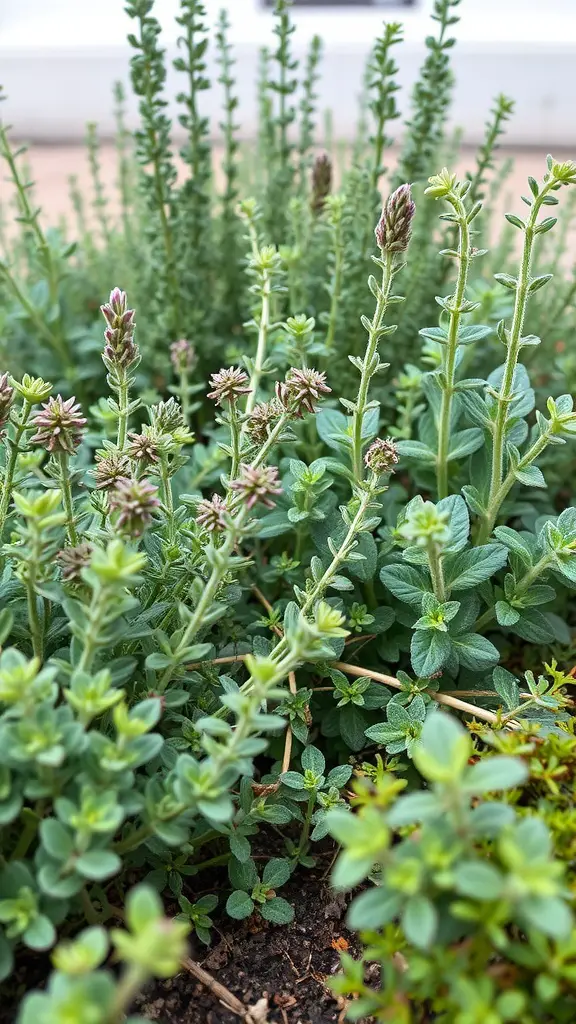
Experience this lively garden view! Thyme and oregano flourish together, forming a beautiful green landscape. Their intense scents and tastes transport the Mediterranean to your home. These herbs share similar growing needs, making them ideal partners in your herb garden.
Thyme boasts upright stems and petite leaves. Oregano, in contrast, displays broader, rounder, and slightly fuzzy leaves. This pairing is visually appealing and mutually beneficial for growth. Planted together, they naturally repel pests and encourage robust plant health.
Enhance your culinary creations with these herbs using this easy recipe. Combine roasted vegetables with olive oil, thyme, and oregano for a flavorful experience. Simply chop your preferred vegetables, such as bell peppers, zucchini, and carrots. Drizzle with olive oil, sprinkle with the herbs, and roast until tender. This delicious dish perfectly showcases the distinct flavors of both herbs.
Basil and Tomatoes: A Perfect Match
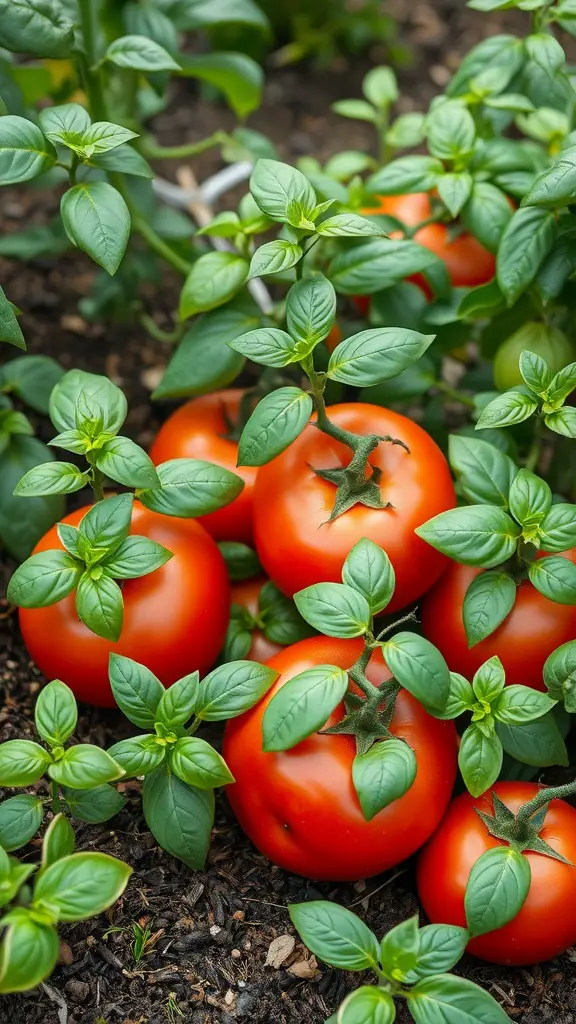
Basil and tomatoes are a perfect garden pairing. The picture shows bright red tomatoes nestled among vibrant green basil. This combination is visually appealing and boosts the growth of both plants.
Growing basil close to your tomato plants can enhance their taste. Gardeners widely recognize that basil’s aroma repels common tomato pests. Additionally, basil flourishes in the same warm environment that tomatoes prefer.
Growing tomatoes and basil together offers culinary advantages. Envision a vibrant tomato and basil salad. Think of a rich, homemade tomato sauce elevated by fragrant basil. The culinary potential is vast!
Begin by planting basil near your tomato plants. Ensure the soil is well-drained and receives ample sunlight. Water consistently and observe their growth together. This beneficial companion planting will undoubtedly lead to a rich and plentiful harvest in your garden.
Sage and Rosemary: Aromatic Allies
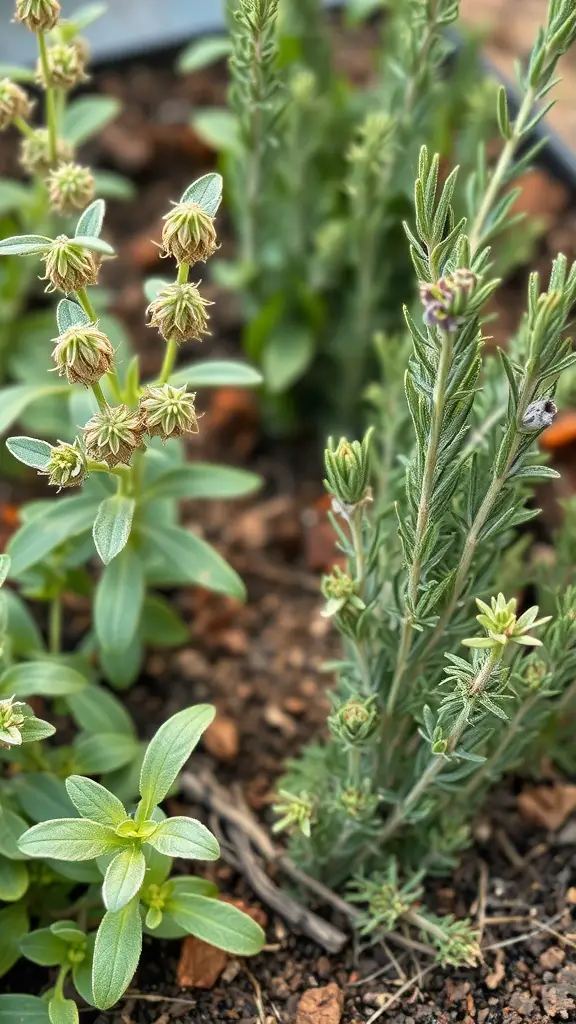
Sage and rosemary are fantastic companion plants. They enhance each other’s growth and look stunning together. This image displays their unique characteristics side-by-side. Sage features soft, rounded, and slightly fuzzy leaves. Rosemary boasts upright growth with slender, needle-like foliage. Their contrasting colors create a visually appealing combination, perfect for any herb garden in 2025.
Growing sage and rosemary in the same garden bed is highly recommended. They share similar needs, such as well-draining soil and ample sunshine. Both are also drought-resistant, simplifying their care. Furthermore, their fragrant leaves can elevate your culinary creations with distinctive tastes. Envision adding rosemary to your next batch of roasted potatoes or incorporating sage into a delicious stuffing recipe!
Cultivating these herbs in tandem can draw helpful insects to your garden. Bees and butterflies are particularly fond of them, boosting your garden’s health. Planning an herb garden? Sage and rosemary are excellent choices. They offer culinary value and enhance your garden’s vitality.
Lavender and Basil: A Scented Partnership
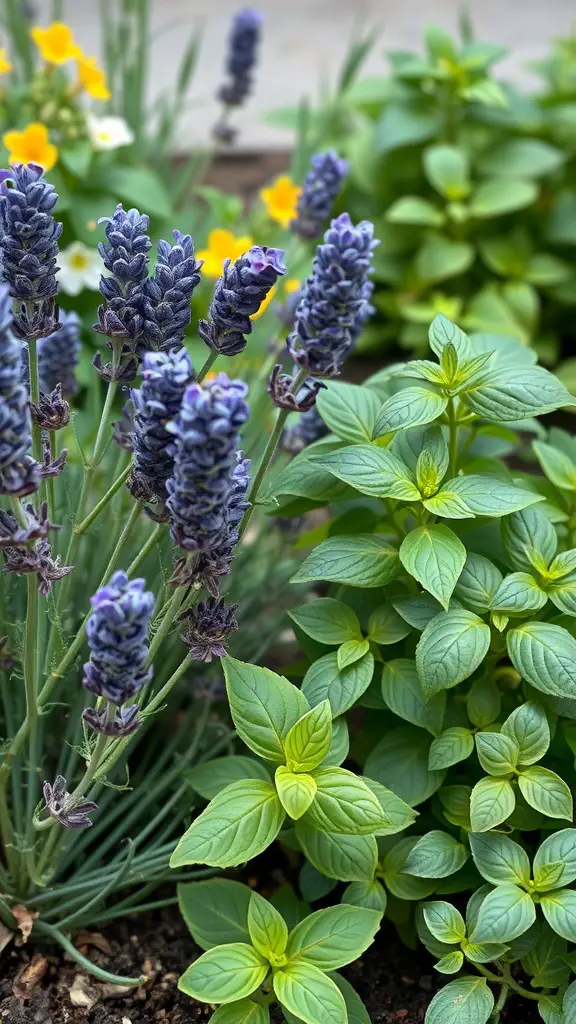
In 2025, lavender and basil remain a winning combination for gardens and culinary creations. Lavender’s deep purple blossoms provide a stunning contrast to basil’s bright green foliage. This pairing results in a visually attractive garden and releases a wonderful fragrance into the surrounding air.
Basil remains a kitchen essential in 2025, particularly for Italian cuisine. Its delightful blend of sweetness and subtle pepperiness harmonizes beautifully with lavender’s delicate floral essence. Explore their combined potential in diverse culinary creations, spanning refreshing salads to rich, flavorful sauces.
Crafting a lavender basil pesto is easy! You’ll need fresh basil, lavender blossoms, olive oil, garlic, and nuts (pine nuts or walnuts work great). Simply blend everything until smooth. This unique pesto adds a delightful twist to traditional recipes. Try it on toast or toss it with pasta for a vibrant, flavorful dish.
Growing these herbs together elevates your cooking and helps each plant flourish. Lavender draws in vital pollinators. Basil grows well in similar conditions. This creates a vibrant and productive garden.
Cilantro and Beans: Thriving Together
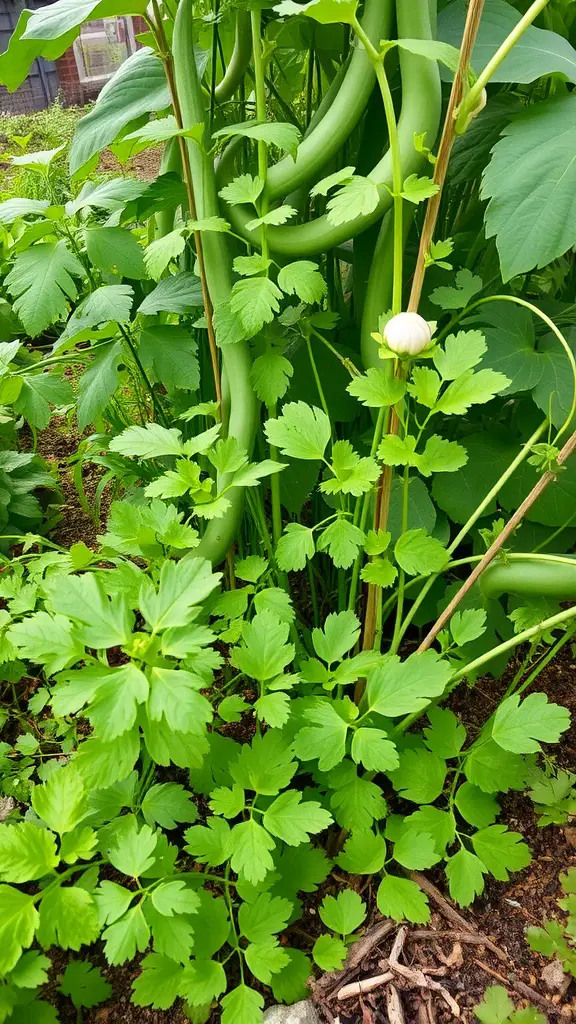
In 2025, cilantro and beans remain excellent garden companions. Observe in the image how thriving cilantro plants are comfortably situated amongst towering bean plants. This pairing is visually appealing and mutually beneficial for both species.
Cilantro thrives in the bean plants’ shade, showcasing its bright green foliage. The beans offer crucial support, and the cilantro naturally repels pests that could harm the beans. This beneficial relationship ensures robust growth for both plants!
For companion planting, timing is key. Plant beans initially, as their germination takes longer. After they reach a few inches in height, sow cilantro seeds nearby. Both thrive in sunny locations, ensuring ample sunlight exposure is crucial.
Want to elevate your recipes? Cilantro brings a vibrant zest to bean-based meals. Picture a basic bean salad enhanced with fresh cilantro. Combine cooked beans, diced tomatoes, chopped onions, and a generous amount of cilantro. A squeeze of lime juice completes this revitalizing dish.
Chives and Carrots: Flavorful Pairing
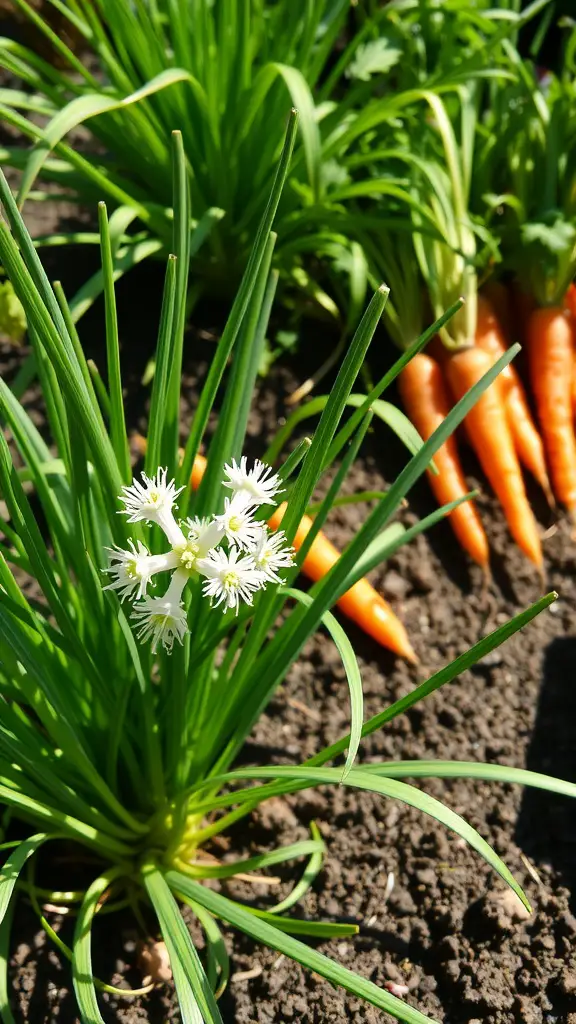
Chives and carrots are a fantastic garden pairing. The slender, bright green chives reach upwards, contrasting with the vibrant orange carrots emerging from the earth. This photo perfectly captures their symbiotic relationship, highlighting the chives in bloom, adding a touch of white to the landscape.
Planting chives with carrots offers more than just visual appeal. It’s a strategic move for improved taste and plant well-being. Chives subtly infuse a delicate onion essence, perfectly complementing the sweetness of carrots. Furthermore, they draw in helpful bugs, naturally controlling unwanted pests.
Eager to explore this flavor combination? Try a quick carrot and chive salad. Combine diced carrots with freshly cut chives. Add a drizzle of olive oil and a squeeze of lemon. Season with salt and pepper to taste. This vibrant salad showcases the delightful taste of both ingredients.
Companion Planting Basics
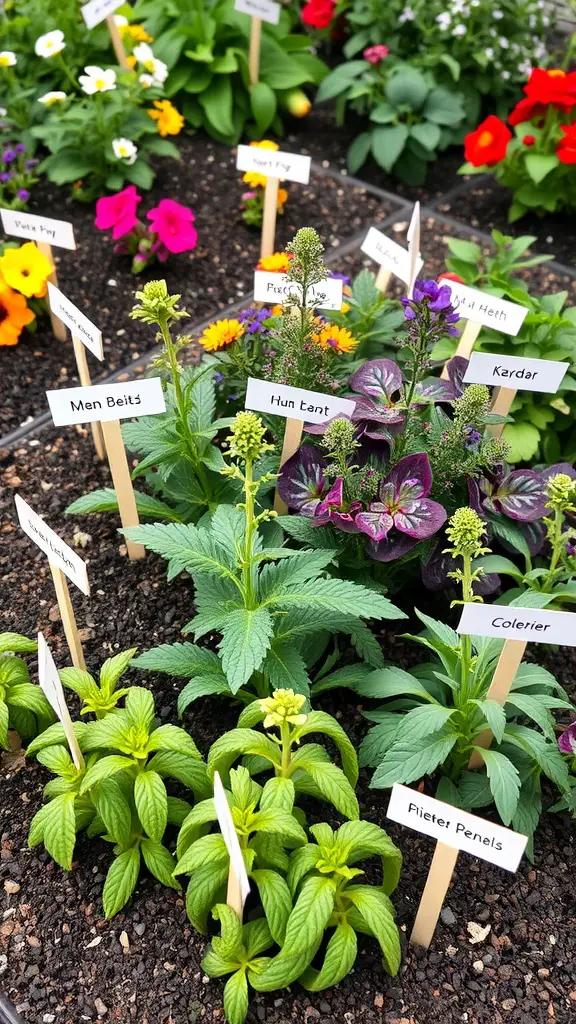
Companion planting focuses on cultivating plants that benefit each other. The image showcases a flourishing garden with diverse herbs, clearly labeled for identification. This arrangement simplifies plant recognition and emphasizes the visual appeal of herbs growing in harmony.
When combining herbs in your garden, think about their potential benefits to one another. Certain herbs naturally ward off unwanted pests. Others draw in helpful insects. For instance, mint planted close to vegetables can keep pests away. Basil, when grown with tomatoes, can boost their flavor. In a well-planned herb garden, each plant has a role. This makes the space both useful and beautiful.
A well-chosen blend of herbs can transform your garden into a welcoming haven and boost its ecological health. Don’t hesitate to try different combinations to find what thrives in your specific environment. The key is to foster a balanced environment where all your plants can flourish together harmoniously. Consider updated 2025 gardening techniques for optimal results.
Dill and Cucumbers: A Refreshing Combo

Cucumbers and dill create a perfect garden partnership. Their combination is visually appealing and enhances summer recipes with fresh flavors. The image displays a thriving cucumber plant nestled among dill, illustrating their harmonious growth.
Cucumbers flourish in warm climates, and dill shares this preference. Planting them together saves garden space and provides mutual support. Dill naturally deters cucumber pests, simplifying your gardening tasks. This companion planting method is highly effective.
Got fresh cucumbers and dill? Make a quick cucumber salad! Slice the cucumbers and mix with chopped dill. Add a pinch of salt and a splash of vinegar. This refreshing side dish is great with grilled meats!
Tarragon and Eggs: Culinary Partners
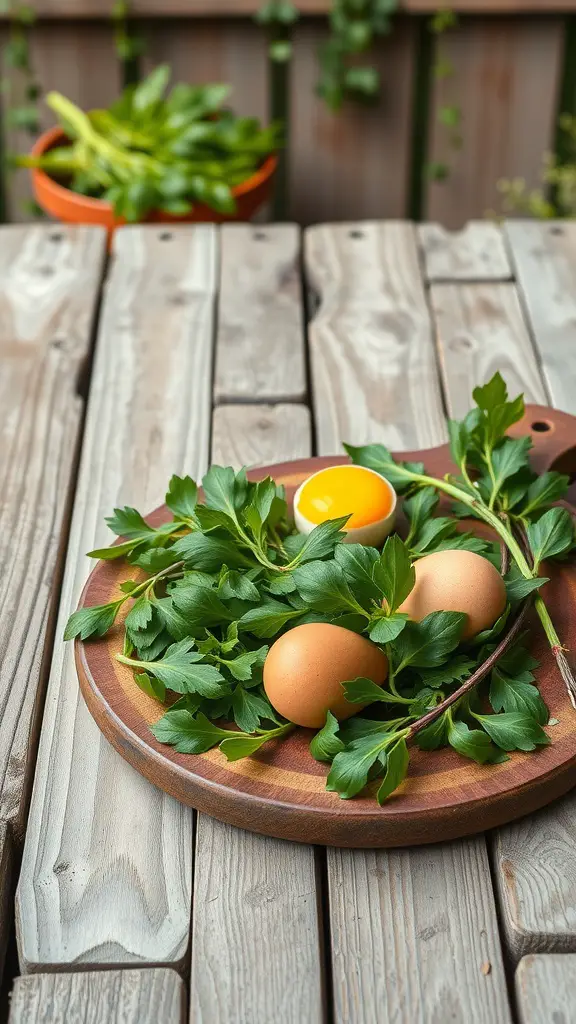
Tarragon and eggs create a fantastic flavor synergy. The picture showcases fresh tarragon leaves alongside eggs, emphasizing this delicious pairing. Incorporating fresh herbs, such as tarragon, can significantly enhance everyday meals.
For a delightful experience, try a tarragon omelet. Gather eggs, fresh tarragon, salt, and pepper. Whisk the eggs with chopped tarragon. Heat a non-stick pan, then pour in the egg mixture. Cook until firm. Fold and enjoy this flavorful dish!
Discover how tarragon elevates the taste of eggs in this straightforward recipe. It’s an excellent way to kick off your morning with a vibrant and delicious meal. Furthermore, cultivating tarragon in your own garden is simple, making it an ideal herb to grow with your other preferred plants.
Lemon Balm and Fish: Flavor Enhancement
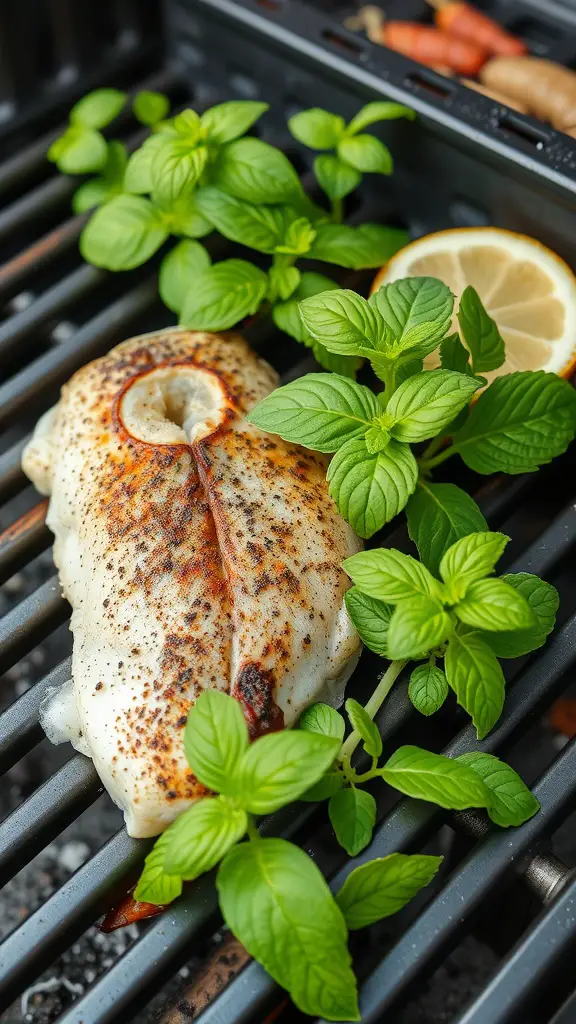
Lemon balm, a fragrant herb, adds a bright, citrusy note to countless recipes. Its pairing with fish is exceptional, enhancing the flavor for a truly delightful meal. This image beautifully showcases grilled fish, adorned with fresh lemon balm leaves, emphasizing their harmonious combination.
Grilling fish remains a favorite cooking technique, enhancing its natural flavors. The smoky char on the outside pairs perfectly with the zesty taste of lemon balm. This combination creates a delicious and visually stunning dish, perfect for any occasion.
Whip up a quick and delicious meal using minimal ingredients. Grab some fresh fish fillets, lemon balm, a lemon, and a touch of olive oil. Season the fish with salt and pepper. Then, add fresh lemon balm leaves and lemon slices on top. Grill until fully cooked. Enjoy a fresh, flavorful, and incredibly easy-to-make dish!
Fennel and Asparagus: Unique Companions
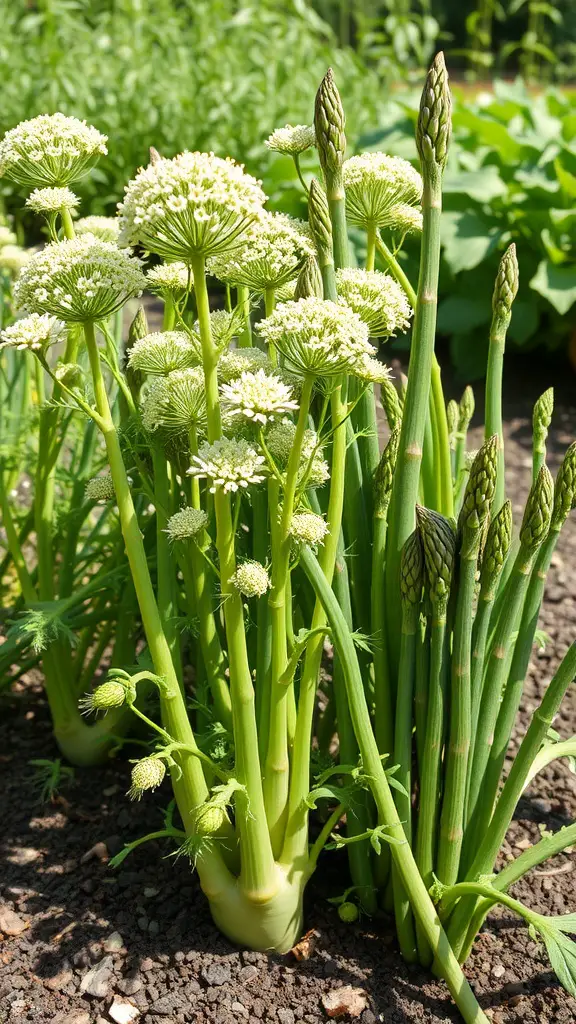
Asparagus and fennel are excellent companion plants for your garden. Their contrasting textures and distinct flavors create a visually appealing and beneficial partnership. The image showcases the asparagus’s tall, graceful stalks next to the fennel’s delicate, white flower clusters. This combination enhances both plants’ growth and overall garden health.
Fennel naturally deters asparagus pests, making it an excellent companion plant. Asparagus, in turn, offers fennel shade during intense sunlight. This symbiotic relationship benefits both plants and promotes a thriving garden ecosystem. Consider this pairing for a healthier and more productive garden in 2025.
Cultivating asparagus and fennel together elevates your culinary creations. Envision a dish showcasing delicate asparagus paired with fennel’s unique anise taste. Roast them simply with olive oil and a touch of salt for an easy, delicious meal. Complement this with grilled chicken for a revitalizing and flavorful dinner experience.
Oregano and Marjoram: Similar Yet Different
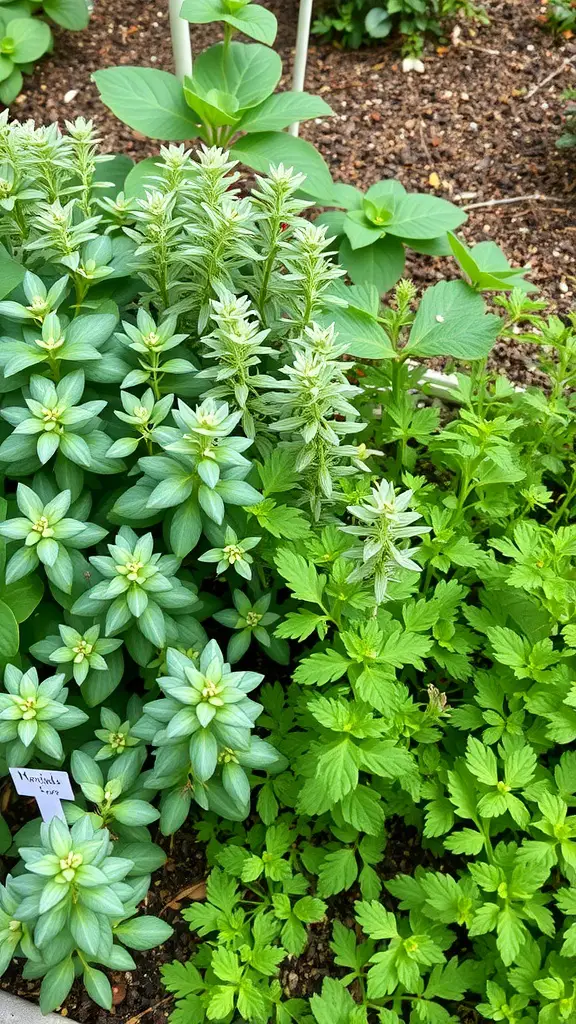
Oregano and marjoram are popular culinary herbs, frequently grown together. The image shows them flourishing in a garden. Oregano boasts strong leaves with a slightly fuzzy feel. It’s a kitchen essential. Marjoram has softer leaves and a gentler scent. It’s perfect for seasoning delicate meals.
Though visually alike, oregano and marjoram offer unique tastes. Oregano delivers a robust, peppery punch, ideal for rich dishes such as pasta and pizza. Marjoram presents a gentler, sweeter profile, enhancing lighter fare like soups and salads.
Cultivating them in tandem offers advantages. Both flourish under comparable conditions, preferring warmth and well-draining earth. Furthermore, having both herbs readily available allows for culinary exploration. Picture a vibrant pasta creation, enhanced by oregano’s zest and marjoram’s subtle, comforting notes.
Therefore, regardless if you’re an experienced cook or a beginner, think about growing these two herbs in tandem. Their contrasting profiles offer a fantastic spectrum of tastes, enhancing your culinary creations.
Parsley and Peppers: A Flavorful Duo
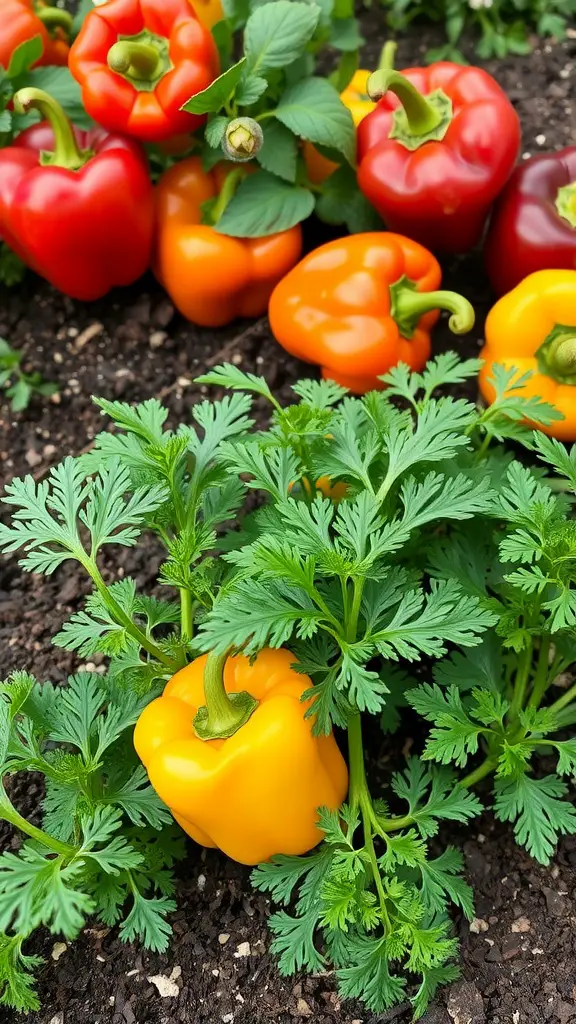
Parsley and peppers create a stunning visual harmony in any garden. Bell peppers, with their vivid hues of red and yellow, provide a striking contrast to parsley’s deep green foliage. This pairing elevates your garden’s beauty and provides diverse culinary flavors for your kitchen.
Harvesting parsley? Its vibrant, fresh, and subtly peppery flavor is a fantastic match for the sweetness of bell peppers. This combination enhances countless dishes, from simple salads to complex stir-fries. Picture a refreshing salad with chopped parsley and diced bell peppers. Or consider using them as a flavorful stuffing for your next roast. They’re a culinary power couple!
Want to combine these flavors? Try a straightforward recipe. Simply prepare bell peppers by removing their cores. Then, stuff them with a blend of minced parsley, cooked rice, and your preferred protein source. Bake until the peppers soften. The result? A delicious meal showcasing the unique tastes of each ingredient.
Bay Leaves and Beans: A Winning Combo
In a 2025 garden setting, bay leaves and beans create a beautiful combination. The bay plant’s rich, green foliage offers a striking contrast to the upward growth of the bean vines. This picture showcases their thriving partnership, emphasizing their harmonious coexistence in the garden.
Bay leaves, celebrated for their aromatic scent, infuse a deep flavor into countless recipes. Planting them near beans promotes a healthier garden ecosystem. Bean plants benefit from the partial shade offered by the taller bay trees. This symbiotic pairing boosts growth and simplifies gardening practices.
Crafting culinary delights is easy with the right ingredients. Picture a straightforward bean recipe, enhanced by the subtle flavor of bay leaf. Simply soak dried beans overnight, then simmer them with bay leaves, garlic, and onions. A final touch of salt harmonizes the flavors perfectly.
Cultivating bay laurel and beans in the same garden space is highly recommended. They naturally support each other’s growth. Fresh bay leaves are readily available for your culinary creations! Plant them in close proximity to maximize the advantages of this beneficial pairing.
Mint and Cabbage: Natural Pest Control

Discover the power of companion planting! Mint and cabbage make excellent garden partners. Growing them together naturally deters pests, promoting healthier growth. The image showcases lush mint plants encircling a robust cabbage, demonstrating their successful symbiotic relationship. This updated 2025 gardening tip will help you maximize your harvest!
Mint’s potent aroma naturally repels many garden pests. This makes it an excellent companion plant for cabbage. Cabbage often attracts troublesome insects. Planting mint nearby helps protect your cabbage. It offers a natural pest deterrent, reducing the need for strong chemicals.
This combination offers natural pest management and boosts plant health. Mint’s vibrant foliage aids in retaining soil moisture, benefiting the cabbage. They work together to establish a flourishing garden environment.
Borage and Strawberries: Sweet Companions
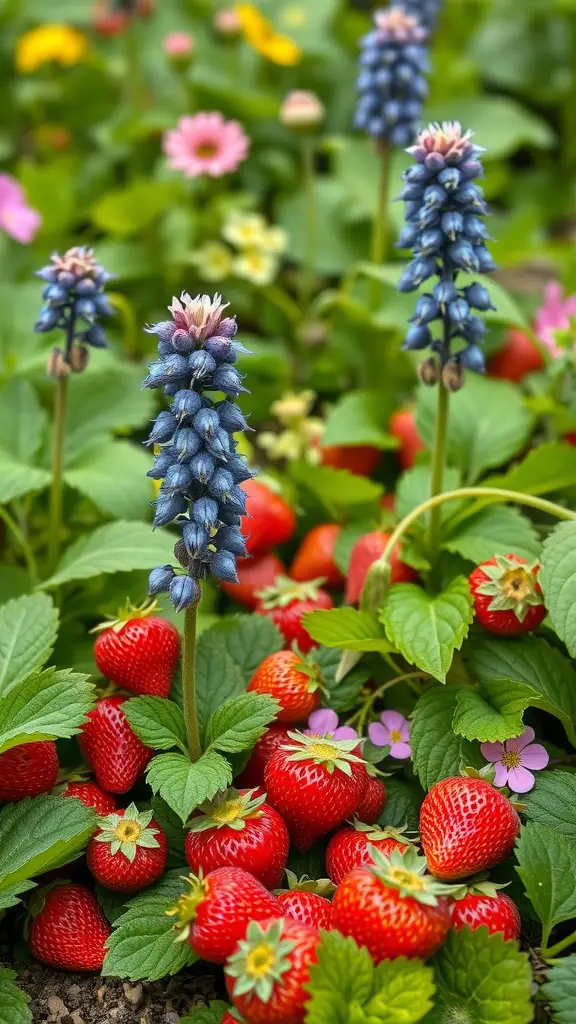
Borage and strawberries are a fantastic garden duo. Borage’s vibrant blue blossoms tower over the strawberry plants’ verdant foliage, crafting a visually appealing display. The strawberries’ bright red fruits perfectly enhance the borage, making this pairing both aesthetically pleasing and advantageous for plant development.
Borage is a fantastic companion plant! It draws in vital pollinators, boosting your strawberry harvest. Its leaves also offer natural shade, shielding strawberries from intense sunlight. This pairing naturally deters pests, fostering a thriving garden for your plants.
Planning to grow them together? Ensure adequate spacing. Strawberries tend to spread, while borage can reach considerable heights. This approach promises a rich harvest of delicious strawberries. Plus, enjoy the beautiful borage flowers in your garden.
Calendula and Herbs: Beauty and Utility
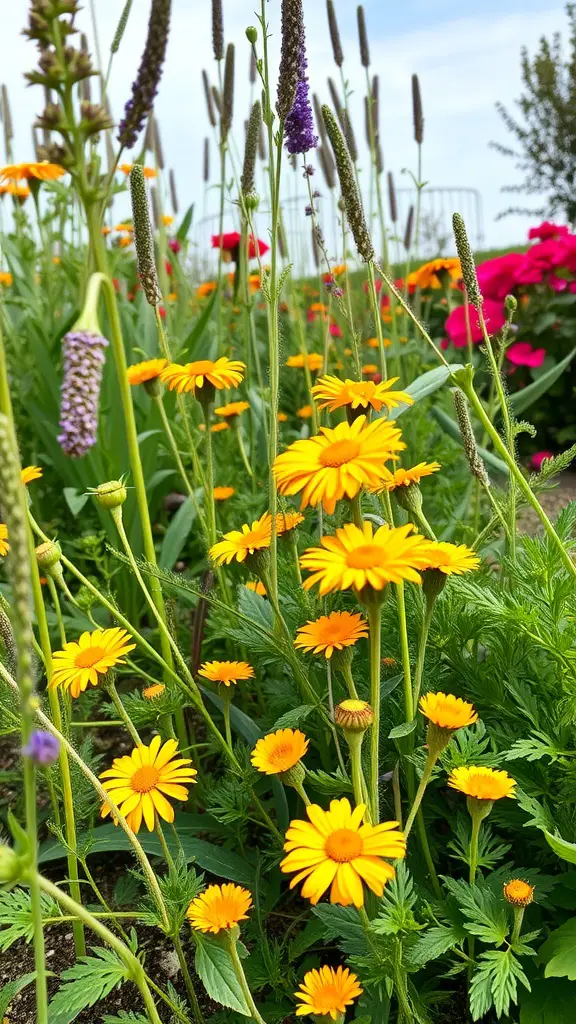
Calendula, known for its sunny yellow blossoms, offers more than just beauty to your garden. It complements a variety of herbs, enhancing both the visual appeal and practical benefits of your garden design. The picture showcases a colorful area where calendula thrives alongside other herbs and flowers, resulting in a dynamic and engaging garden environment.
These vibrant flowers draw in helpful bugs, aiding in pollination and managing pests. Planting calendula alongside herbs such as basil or thyme can boost their growth and intensify their taste. Furthermore, calendula petals add a splash of color and a subtle flavor to salads and teas.
Adding calendula to your garden offers numerous benefits, including improved plant health. These vibrant flowers naturally repel pests, allowing your herbs to flourish without harsh chemicals. Calendula is an excellent companion plant for both culinary and decorative gardens, promoting a healthier and more sustainable environment.
Therefore, think about including calendula in your garden plans. It will enhance your outdoor area’s beauty. Plus, its advantages as a companion plant make it a wise decision for any herb garden in 2025.
Herbs for Pollinators: A Buzzing Garden

Cultivating a pollinator-friendly garden is great for your plants and adds beauty to your yard. The picture shows a lively flowerbed full of activity. Butterflies are attracted to the colorful blossoms. Adding herbs can make your garden even better.
Select herbs that naturally draw pollinators. Basil, thyme, and mint are excellent choices. Their tiny flowers are irresistible to bees and butterflies. Combine these herbs with vibrant flowers to build a thriving garden ecosystem.
This vibrant snapshot highlights the crucial role of diverse herb and flower gardens for our environment. They are vital for supporting pollinators and boosting the overall well-being of the garden ecosystem.
Savory and Squash: A Flavorful Alliance
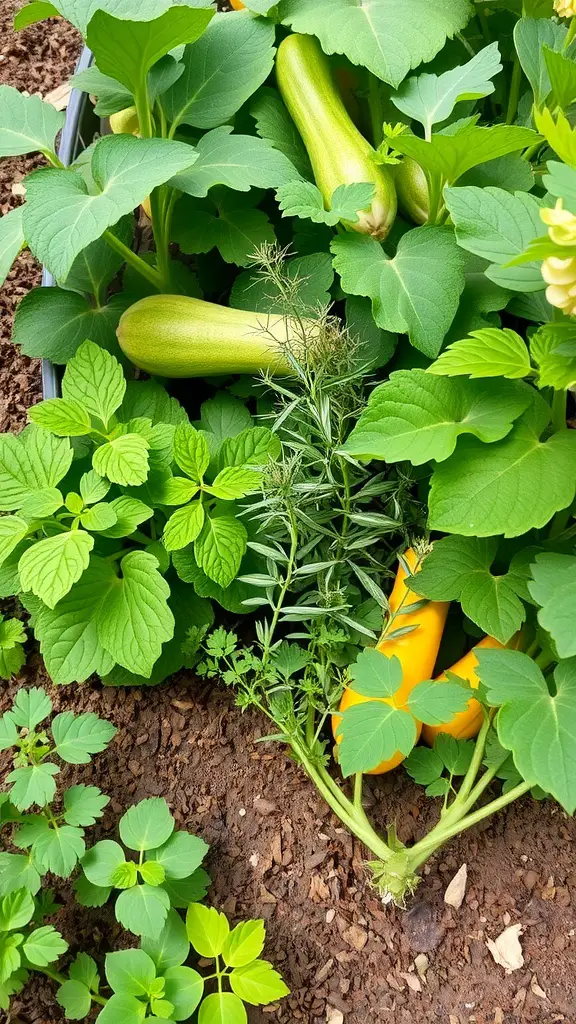
The image displays a thriving garden scene. Herbs and squash plants flourish side-by-side. Their combined greenery forms a vibrant, healthy backdrop. Bright yellow squash peek out, adding a cheerful splash of color to this inviting garden.
Growing flavorful herbs with your squash plants is a great idea for 2025. Rosemary and dill, for example, improve your cooking and naturally repel unwanted pests. This organic pest management leads to stronger plants and a better squash yield.
Squash and savory herbs create amazing culinary possibilities. Picture this: you slice vibrant yellow squash, then mix it with rosemary, olive oil, and a pinch of salt. Roast it until it’s perfectly golden. The result? A simple, flavorful dish that celebrates the squash’s natural taste.
Gardeners, rejoice! Companion planting boosts your garden’s biodiversity. This creates a thriving ecosystem. It attracts helpful insects and deters pests. Witnessing their symbiotic growth is truly rewarding.
Culinary Herb Garden Layout
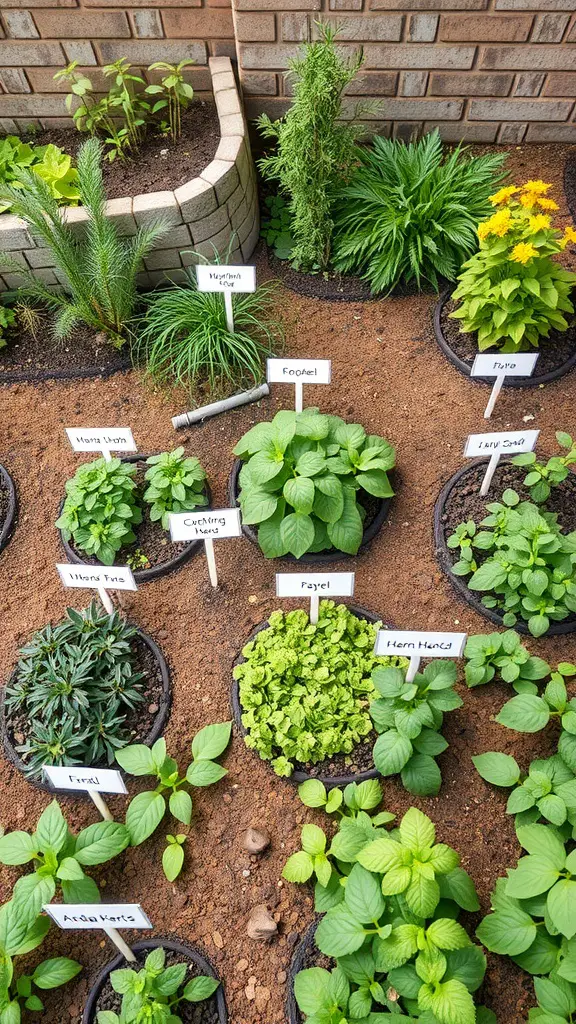
Elevate your cooking by cultivating a vibrant culinary herb garden. The image showcases a thoughtfully arranged herb garden, simplifying identification and access. Notice the clear labels – a fantastic aid for novice gardeners. Consider this layout for your own fresh herb supply in 2025.
Explore our garden, showcasing diverse herbs such as mint, basil, and cilantro. Each flourishes in its own pot. This design is visually attractive and simplifies upkeep. Herbs often benefit from close proximity, promoting robust growth when grouped together.
Plant herbs with matching needs for water and sun together. Basil and cilantro thrive in sunny spots, making them great companions. Their bright green leaves also add a beautiful touch of color to your garden, creating a pleasant space.
No matter your cooking skill, fresh herbs significantly enhance your recipes. Picture adding freshly cut mint to a cool beverage or basil to your pasta. This simple addition elevates your dining experience.
Nasturtiums and Radishes: Edible Flowers
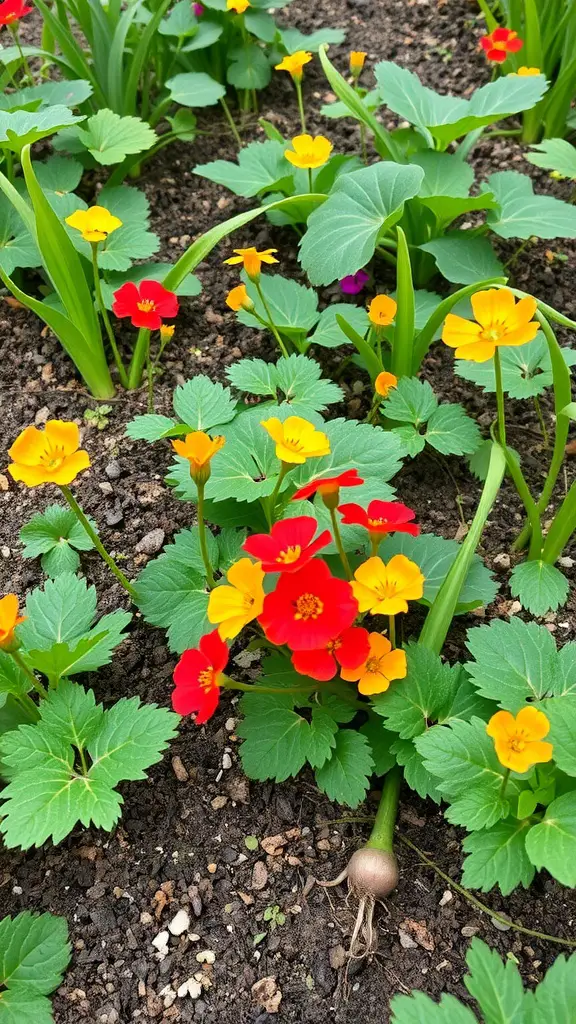
Nasturtiums are more than just beautiful blooms. They bring vibrant color to your garden and offer a unique flavor. Their striking red and yellow flowers create a visually appealing display. These edible flowers boast a peppery zest, much like arugula. This makes them a fantastic addition to salads or a flavorful garnish, perfect for 2025 culinary trends.
This photo showcases vibrant nasturtiums thriving near radishes. Radishes are fast-growing vegetables, and their roots are visible, indicating they’re harvest-ready. Planting nasturtiums and radishes together leverages their beneficial, shared growing characteristics for a successful garden.
Radishes thrive below the soil, and nasturtiums flourish above. This pairing maximizes garden space and aids in natural pest management. Nasturtiums repel destructive insects, safeguarding your radishes and neighboring plants in 2025.
Harvesting nasturtium flowers? Add them to salads for vibrant color and a peppery taste! Remember to wash them well first. Both nasturtiums and their companion plants flourish in sunny spots with well-drained soil. This makes them perfect garden buddies.
Herbs for Shade: Growing in Low Light
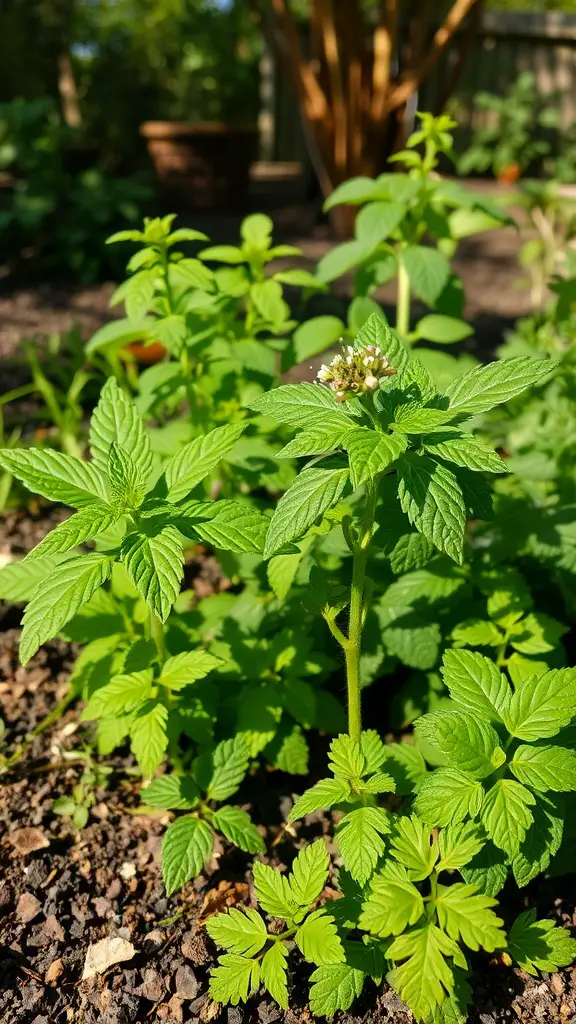
Cultivating herbs in shady spots is both achievable and satisfying. The picture displays a vibrant collection of herbs flourishing in a low-sunlight setting. Observe the bright green foliage, a sign of robust health. These herbs are ideal for those challenging garden locations with minimal direct sunlight.
For herbs that thrive in the shade, consider mint, lemon balm, and chives. These herbs each offer distinct tastes and applications. Mint provides a cool, refreshing touch to beverages and sweets. Lemon balm boasts a delightful lemon scent, ideal for flavoring water or brewing herbal teas. Chives contribute a subtle onion-like zest to salads and various culinary creations.
For herb gardens in shady spots, select shade-tolerant varieties. Use nutrient-rich, well-draining soil. Monitor soil moisture regularly, as shaded areas retain water longer than sunny ones.
Maximize your garden space by cultivating a shade herb garden! Bring vibrant greenery to those low-light areas. Enjoy fresh, homegrown herbs to elevate your culinary creations and drinks.
Herbs for Sun: Maximizing Sunshine
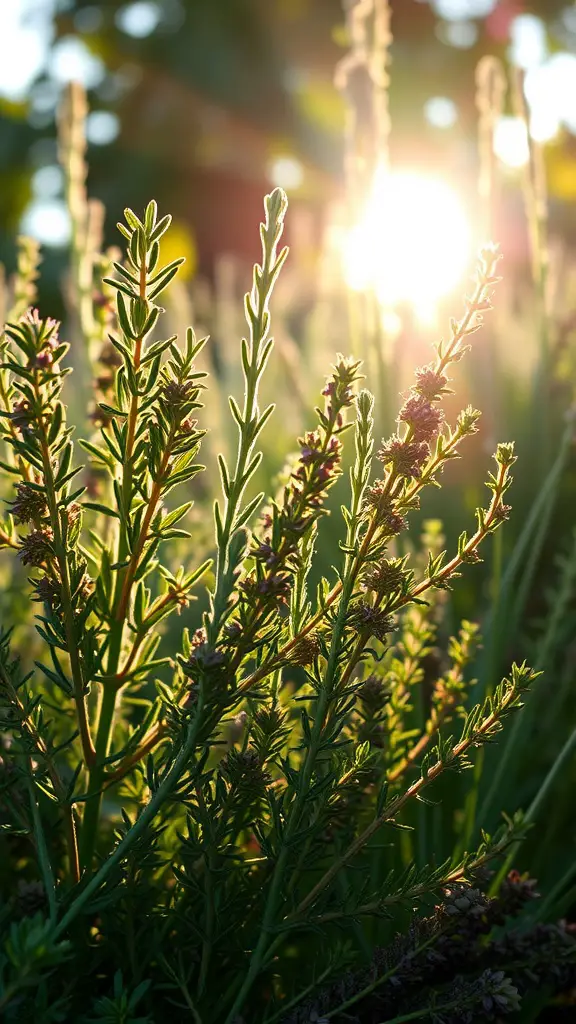
This stunning photo showcases various herbs soaking up the sun’s warmth. Sunlight streams through the leaves, accentuating their distinct forms and textures. It’s a vivid reminder of sunlight’s crucial role in cultivating thriving, flavorful herbs.
For herb gardens basking in sunlight, choose rosemary, thyme, and sage. These sun-loving plants offer fantastic flavors for your culinary creations. Grouping them together provides convenient harvesting for your cooking needs.
Crafting a vibrant herb garden that thrives in sunshine begins with selecting a bright location, be it your garden or balcony. Ensure excellent soil drainage for optimal growth. Plant your herbs either in separate containers or a convenient raised bed. Consistent watering is key, particularly during warmer periods, but avoid excessive moisture.
Harvest your herbs frequently! Regular harvesting promotes new growth. Enjoy fresh ingredients for your cooking. Use them in stews or salads. These sun-loving herbs will elevate your meals.
Seasonal Herb Gardening Tips
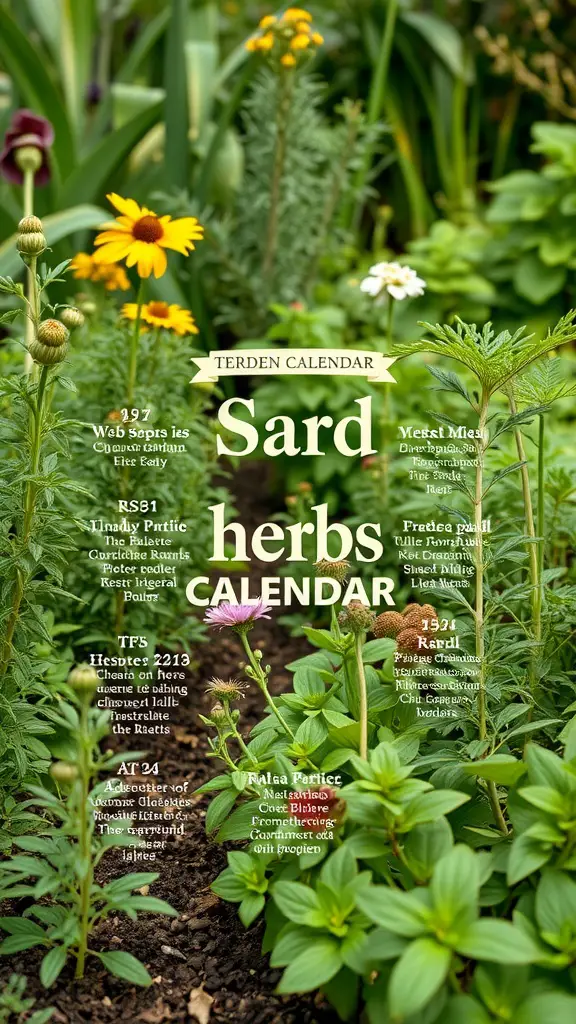
Cultivating herbs offers a rewarding gardening journey. Imagine the diverse range of plants you can combine! The picture showcases a flourishing garden. It’s bursting with herbs and vibrant flowers, creating an energetic ambiance. Strategic seasonal herb planting boosts your garden’s aesthetic appeal and practical value.
Crafting your 2025 herb garden? Consider companion planting for optimal growth. Certain herbs flourish when near specific flowers or other herbs. Basil, for example, complements tomatoes and naturally deters pests. Adding marigolds can also draw beneficial insects, promoting a thriving, healthy garden.
Timing is key when planting herbs. Cilantro and parsley flourish in cooler weather. Basil and oregano thrive in warmer temperatures. Consult a planting calendar for optimal growth.
Also, monitor water and sunlight carefully. Most herbs thrive in well-drained soil with ample sunlight. Consider their growth habits to prevent overcrowding. This arrangement ensures each plant gets sufficient light and nutrients.
Finally, remember to harvest frequently. Regular trimming promotes fresh growth and maintains herb health. Best of all, you can savor fresh herbs in your meals!
Herb Spiral Design: Maximizing Space

Elevate your garden with an herb spiral, a clever design for any outdoor area. It optimizes both vertical and horizontal space, allowing you to cultivate a diverse collection of herbs in a compact area. The picture displays a vibrant spiral bursting with greenery and blossoms, demonstrating how to craft an appealing and functional herb garden. This updated design for 2025 is perfect for modern gardening.
Spiral gardens efficiently organize plants based on their specific water and sunlight requirements. The elevated top section, warm and dry, is ideal for Mediterranean herbs such as thyme and rosemary. Descending the spiral, conditions become cooler and more humid, creating a suitable environment for herbs like mint and parsley. This design is visually appealing and promotes biodiversity, offering natural pest control benefits.
Begin by crafting a basic spiral using stones or bricks. Populate it with your preferred herbs. Incorporate companion flowers to draw in pollinators. Ensure you select herbs that flourish together and enhance each other’s growth. A prime example is basil and tomatoes; they pair perfectly and thrive in the same space.
Effortlessly maintain your herb spiral! Consistent watering and strategic pruning ensure vibrant, productive plants. Enjoy fresh, homegrown herbs, elevating your culinary creations and filling your garden with delightful fragrances.
Growing Herbs in Containers

Growing herbs in containers is enjoyable and efficient, particularly when space is limited. This image displays a beautiful assortment of potted herbs, perfect for thriving on a patio or balcony.
Each container features a unique herb, like mint, basil, rosemary, and parsley. This selection provides diverse flavors readily available. Forget large gardens; a few pots bring fresh herbs to your kitchen!
Select pots with excellent drainage. Herbs thrive in well-draining soil. Ensure your chosen containers have drainage holes. Opt for standard plastic pots or explore decorative alternatives to enhance your space’s aesthetic.
Arranging pots in clusters, like the picture illustrates, maximizes space and adds visual appeal. Taller plants can provide beneficial shade for certain herbs. Companion planting herbs can also draw more pollinators to your garden.
Remember to check your herbs frequently. They require sufficient sunlight, water, and fertilizer for optimal growth. With a little care, you’ll cultivate a flourishing herb garden just outside your door!
Creating an Herb Garden for Beginners
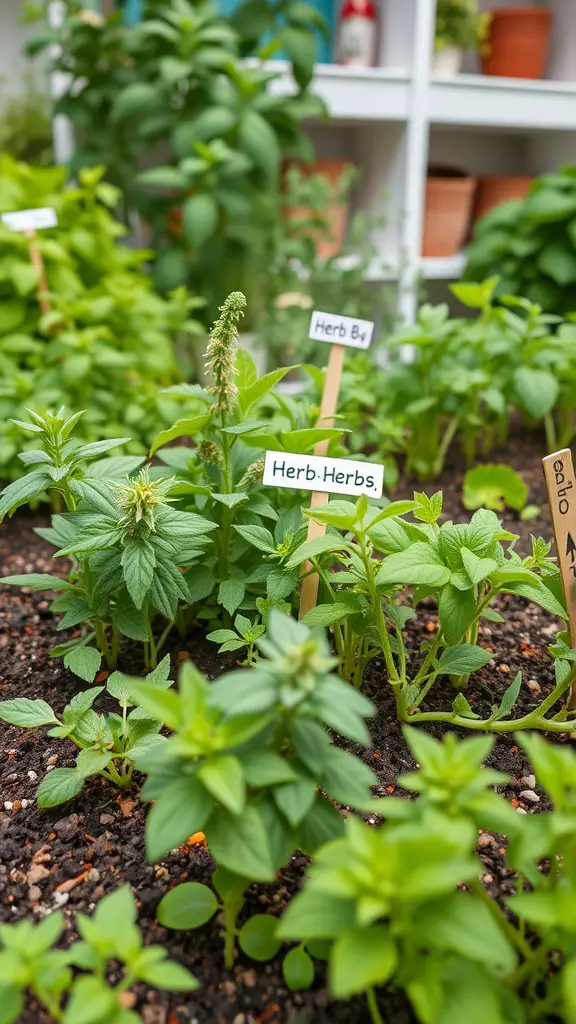
Embarking on your own herb garden journey is both enjoyable and fulfilling. Observe this captivating image showcasing a flourishing herb garden with diverse plants. Notice the labeled markers for each herb; a clever method for monitoring your plantings.
Up front, vibrant green foliage signals robust, harvest-ready plants. Easy-to-grow herbs such as basil, parsley, and mint are ideal for novice gardeners. They adapt well to different environments and enhance your dishes with their fresh taste.
Start your herb garden by selecting a bright location in your yard or on your balcony. Most herbs thrive with a minimum of six hours of daily sunlight. Plant them directly in the ground or use pots if you have limited space.
After selecting your herbs, focus on soil preparation. A quality, well-draining potting mix is ideal for container herbs. For in-ground planting, ensure the soil is loose and enhanced with compost.
Ensure consistent watering for your herbs, but be careful not to saturate the soil. Allow the soil surface to dry a bit between watering sessions. Harvest fresh leaves as your herbs flourish to elevate your culinary creations. Furthermore, herbs naturally draw in helpful insects, contributing to a healthy and balanced garden environment.
Preserving Herbs for Year-Round Use
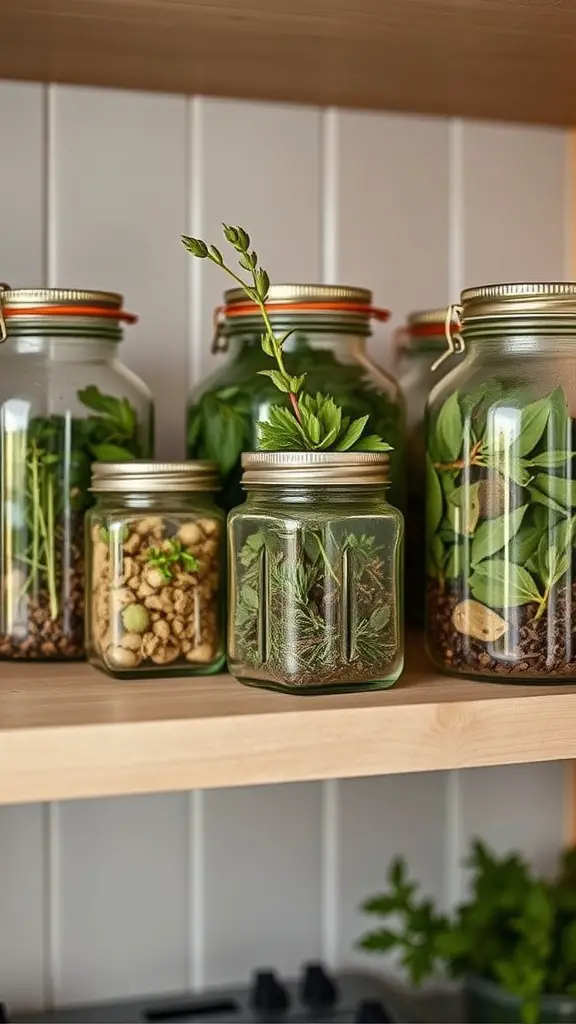
Want fresh herbs anytime? Preserving them is essential! The picture shows beautiful jars. They’re full of bright green herbs. They sit on a plain wood shelf. Each jar holds unique flavors and scents. These will enhance your cooking, even during winter.
Storing herbs in jars is an excellent method for maintaining their freshness and taste. You’ll often find jars containing various herbs, such as basil and rosemary, each with a clear label for easy identification. This approach effectively preserves the herbs and simplifies the process of locating the right one while preparing meals.
Preserving your fresh herbs is easy with several methods. Consider drying, freezing, or creating flavorful herb-infused oils. To dry, hang small bundles upside down in a cool, dark, and well-ventilated space until completely brittle. For freezing, finely chop your herbs and combine them with a small amount of water in ice cube trays. This provides convenient herb cubes, perfect for adding to soups and sauces.
Want to elevate your cooking? Try crafting herb-infused oils! Simply mix your preferred herbs with oil in a jar. Allow it to steep for about two weeks. The result? A flavorful oil ready to boost your culinary creations. Perfect for salads, marinades, and countless other dishes.
Harvesting and Using Your Herbs
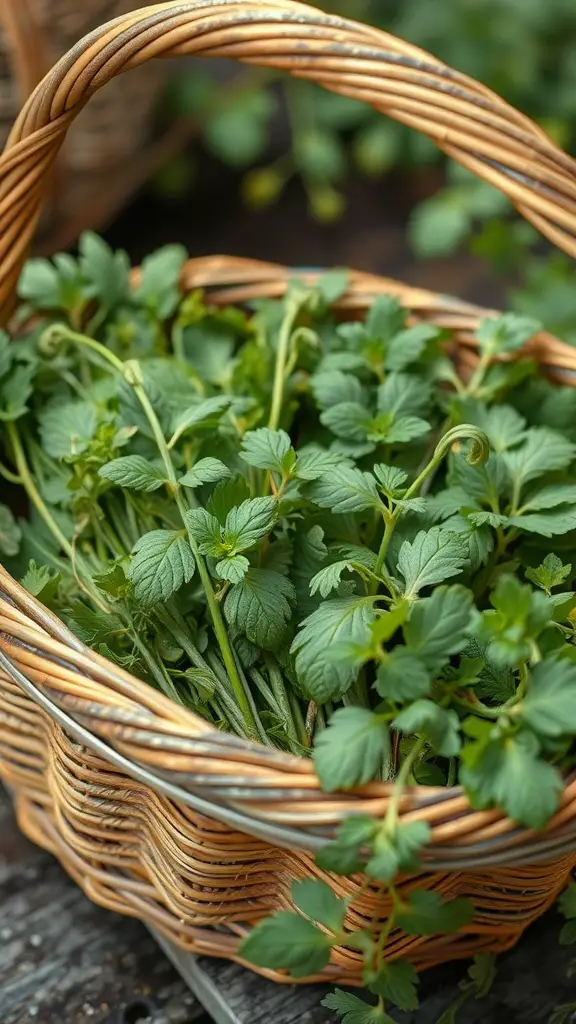
Optimal herb harvesting hinges on precise timing. The picture showcases a beautiful basket brimming with newly gathered herbs, displaying vivid green hues. These herbs enhance your culinary creations, infusing meals with delightful flavors.
Begin by using sharp scissors or garden shears. Make your cuts on the stems right above a leaf node. This promotes fresh growth. Harvest in the morning for the best results. Morning is when essential oils are most concentrated. Your herbs will have the strongest aroma and taste then.
After harvesting, use your herbs immediately or dry them for future use. For fresh herbs, finely chop and add them to salads, soups, or sauces. To dry herbs, bundle them and hang them upside down in a cool, dark area. They’ll be ready for jar storage in a few weeks.
Unlocking the potential of your homegrown herbs is an exciting journey of culinary exploration. Try incorporating them into everyday dishes such as scrambled eggs, pasta sauces, or grilled vegetables. Feel free to experiment with combining different herbs to create distinctive and delightful flavor profiles. For instance, the classic combination of basil and parsley elevates pesto, while rosemary and thyme provide an aromatic touch to roasted meats.
Herbs elevate flavor and boost your health. Many boast anti-inflammatory and antioxidant effects. Incorporating them into meals is a delicious path to wellness.
Composting for Healthy Herbs
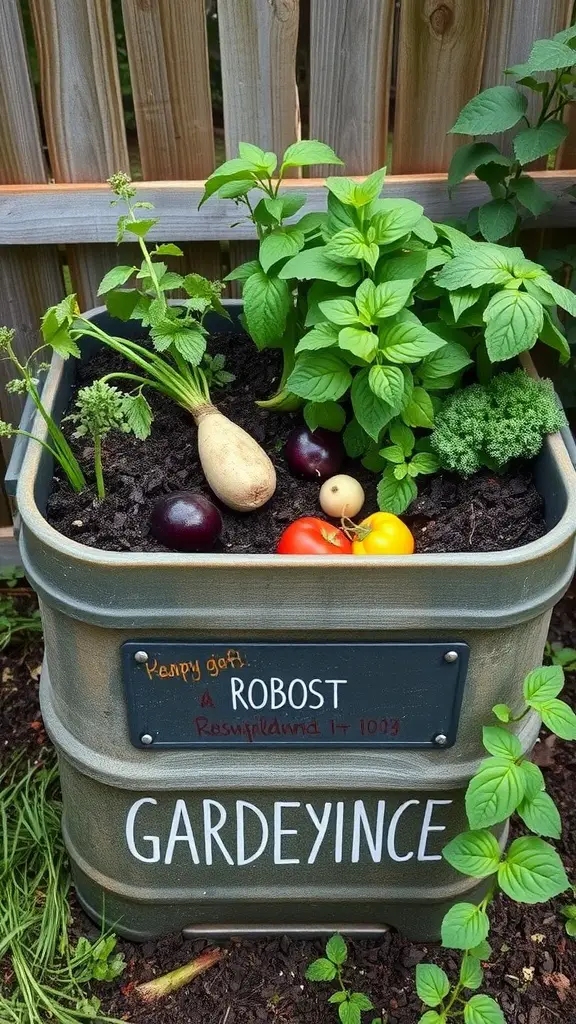
This image showcases a beautiful herb garden thriving in a planter. Notice the lush green basil and mint, complemented by fresh vegetables. This combination highlights the successful synergy between herbs and vegetables, particularly when nurtured with quality compost.
Composting is key to vibrant herb growth. Adding compost enriches your garden soil. It boosts soil structure and delivers vital nutrients. This supports robust and flavorful herbs. The dark, fertile soil in the image likely benefits from composting. It creates an ideal environment for these herbs to thrive.
Transform kitchen and garden leftovers into valuable soil using a compost bin! Vegetable peels, coffee grounds, and fallen leaves decompose, creating nutrient-rich soil. This sustainable approach nourishes your herbs and minimizes waste, promoting an eco-conscious lifestyle.
Using compost in your garden boosts plant health and vitality. The herbs pictured here look incredibly healthy and vibrant. Beyond their beauty, they’re packed with flavor, ideal for culinary use. Start composting today and see your herbs thrive!

